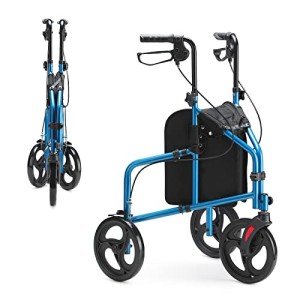lightweight-walker1521
lightweight-walker1521
5 Killer Quora Answers To Indoor Walker
The Rise of Indoor Walkers: A Comprehensive Guide
Indoor walkers have become a popular option for people seeking to preserve an active way of life within the boundaries of their homes. These versatile machines deal with a varied audience, from fitness lovers to those recovering from injuries. This short article will dive into the fundamentals of indoor walkers, their benefits, types, and some factors to consider to remember before buying one.
What is an Indoor Walker?
An indoor walker is a fitness maker designed to imitate walking without the requirement for outdoor area. Unlike traditional treadmills, which mostly focus on running and running, indoor walkers highlight a natural walking motion. They are equipped with features that promote stability, support, and comfort, making them appropriate for a wide variety of users.

Why Choose an Indoor Walker?
Indoor walkers come with a myriad of benefits that interest users of any ages and fitness levels. A few of the main advantages consist of:
- Convenience: They can be used anytime, despite weather condition conditions or time, making it much easier to fit workout into a hectic schedule.
- Low Impact: Indoor walkers are created to lower strain on joints, making them an outstanding option for those with mobility concerns or joint concerns.
- Space-Efficient: Many models are compact and easy to store, fitting into little apartments or homes with limited area.
- Range of Workouts: With adjustable speeds and strength levels, users can customize their exercises to their physical fitness objectives.
Kinds Of Indoor Walkers
Indoor walkers been available in various styles, each accommodating different user requirements. Here are a few of the most common types:
| Type | Description | Perfect For |
|---|---|---|
| Manual Walkers | Run by the user, moving the arms and legs in a walking motion. | Beginners looking for a simple, economical alternative. |
| Motorized Walkers | Equipped with a motor to control speed and slope settings. | Those wanting a more versatile workout experience. |
| Under-desk Walkers | Compact machines that fit under desks, promoting walking while working. | People working from home seeking to remain active. |
| Recumbent Walkers | Enable users to stroll in a seated position, reducing tension on the body. | Older adults or those with mobility obstacles. |
Secret Features to Consider
When choosing the ideal indoor walker, numerous features can impact the overall exercise experience. Here are some essential factors to consider:
- Size and Portability: Ensure it fits your designated exercise location and is easily movable if required.
- Weight Capacity: Check the optimum weight limitation to make sure safety throughout exercises.
- Adjustable Settings: Look for machines that offer adjustable speed and slope settings to customize your workouts.
- User-Friendly Display: Choose an indoor walker with an easy-to-read display that tracks time, range, calories burned, and speed.
- Convenience Features: Consider padded deals with, adjustable height, and a sturdy base for improved stability and convenience.
Health Benefits of Indoor Walking
Engaging in routine indoor walking can yield numerous health benefits:
- Enhanced Cardiovascular Health: Walking increases heart rate and improves blood flow, lowering the risk of heart illness.
- Weight Management: Regular walking, integrated with a well balanced diet, aids in weight control and can add to weight-loss.
- Improved Mood: Physical activity releases endorphins, which can help in reducing feelings of anxiety and depression.
- Reinforced Muscles: Indoor walking enhances the leg muscles and improves general body coordination and balance.
Establishing a Walking Routine
To optimize the benefits of indoor walking, it’s important to develop a constant routine. Here are some ideas to get started:

- Create a Schedule: Dedicate particular times throughout the week for walking. Go for at least 150 minutes of moderate aerobic activity weekly.
- Heat up and Cool Down: Always start with a 5-minute warm-up to prepare your body and finish with a cool-down to assist recovery.
- Listen to Your Body: Pay attention to how you’re feeling. If you experience pain or discomfort, stop and assess your body’s requirements.
Frequently Asked Questions (FAQs)
Q: How much space do I need for an indoor walker?A: Most indoor walkers are compact and require a small footprint. It’s a good idea to have at least 6 to 8 square feet offered for a safe workout area. Q: Can indoor walkers be used by olderadults?A: Yes, indoor walkers are exceptional for older adults as they supply low-impact exercise while promoting stability and mobility. Q: Do I require a health club subscription if I have an indoor walker?A: No, having an indoor walker permits you to engage in cardio exercises in your home, negating the requirement for a gym subscription for walking workouts. Q: How do I keep my indoor walker?A: Regularly look for loose screws, tidy the maker after use, and follow the maker’s standards for specific upkeep schedules. Q: Are indoor walkers appropriate for rehabilitation?A: Yes, numerous indoor walkers are designed to support rehab, especially for patients recovering from surgery or injury. Constantly seek advice from a healthcare professional before beginning a new workout regimen. Indoor walkers offer a practical and efficient method to integrate physical activity into life. With their several health benefits, user-friendly styles, and adaptability, they are an outstanding investment for anyone wanting to improve their
physical fitness levels in the convenience of their home. By understanding the different types of indoor walkers, key features to think about, and the health benefits of walking, people can make educated choices that align with their physical fitness objectives. With dedication and the ideal devices, remaining active has never ever been easier.


